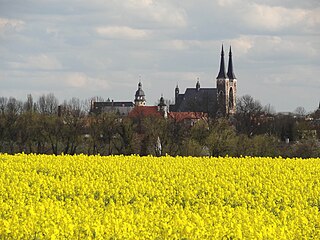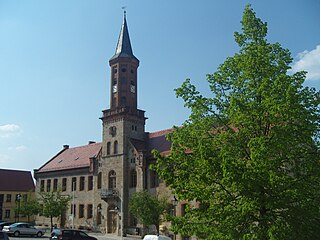
Saxony-Anhalt is a state of Germany, bordering the states of Brandenburg, Saxony, Thuringia and Lower Saxony. It covers an area of 20,451.7 square kilometres (7,896.4 sq mi) and has a population of 2.17 million inhabitants, making it the 8th-largest state in Germany by area and the 11th-largest by population. Its capital is Magdeburg, its most populous city, however, is Halle (Saale).

Köthen ( ) is a town in Germany. It is the capital of the district of Anhalt-Bitterfeld in Saxony-Anhalt, about 30 km (19 mi) north of Halle.

Aken (Elbe) (German pronunciation:[ˈaːkən] ) is a town in the district of Anhalt-Bitterfeld in Saxony-Anhalt, Germany. The town is located at the left bank of the river Elbe.

Ballenstedt is a town in the Harz district, in the German state of Saxony-Anhalt.

Harzgerode is a town in the district of Harz in Saxony-Anhalt, Germany.

Burg is a town of about 22,400 inhabitants on the Elbe–Havel Canal in northeastern Germany, 25 km (16 mi) northeast of Magdeburg. It is the capital of the Jerichower Land district in the state of Saxony-Anhalt.

Weißenfels is the largest town of the Burgenlandkreis district, in southern Saxony-Anhalt, central Germany. It is situated on the river Saale, approximately 30 km (20 mi) south of Halle.

Wolmirstedt is a town in the Börde district in Saxony-Anhalt, Germany. It is located 14 km north of Magdeburg, on the river Ohre. The town Wolmirstedt consists of Wolmirstedt proper and the Ortschaften Elbeu, Farsleben, Glindenberg and Mose.

Haldensleben is a town in Saxony-Anhalt, Germany. It is the administrative seat of the Börde district.

Calbe is a town in the district of Salzlandkreis, in Saxony-Anhalt, Germany.

Nienburg is a town in the district of Salzlandkreis in Saxony-Anhalt, Germany. It is located in the lower Saale valley, approx. 5 km northeast of Bernburg. In January 2010 it absorbed the former municipalities Gerbitz, Latdorf, Neugattersleben, Pobzig and Wedlitz, that became Ortschaften or municipal divisions of the town. In 2020 its population was 6,104.

Egeln is a small town in the Salzlandkreis district, in Saxony-Anhalt, Germany. It is the administrative seat of the Verbandsgemeinde Egelner Mulde.

is a town in the district of Salzlandkreis, in Saxony-Anhalt, Germany. It is situated on the right bank of the river Saale, approx. 15 km south of Bernburg, and 25 km northwest of Halle (Saale).

Güsten is a town in the district of Salzlandkreis, in Saxony-Anhalt, Germany. It is situated on the river Wipper, west of Bernburg. It is part of the Verbandsgemeinde Saale-Wipper. It absorbed the former municipality Amesdorf in January 2010.

Genthin is a town in Jerichower Land district, in Saxony-Anhalt, Germany.

Möckern is a town in the Jerichower Land district, in Saxony-Anhalt, Germany. It is situated east of Magdeburg. The Battle of Möckern took place south of the town in 1813.

Mansfeld, sometimes also unofficially Mansfeld-Lutherstadt, is a town in the district of Mansfeld-Südharz, in Saxony-Anhalt, Germany.

Allstedt is a town in the district of Mansfeld-Südharz, in Saxony-Anhalt, Germany. It is situated approximatively 10 km southeast of Sangerhausen.

Barby is a town in the Salzlandkreis district, in Saxony-Anhalt, Germany. It is situated on the left bank of the River Elbe, near the confluence with the Saale, approx. 25 km (16 mi) southeast of Magdeburg. Since an administrative reform of 1 January 2010 it comprises the former municipalities of the Verwaltungsgemeinschaft Elbe-Saale, except for Gnadau, that joined Barby in September 2010. The Barby Ferry, a reaction ferry across the Elbe, links Barby with Zerbst-Walternienburg.

Trematosaurus is an extinct genus of trematosaurid temnospondyl amphibian found in Germany and Russia. It was first named by Hermann Burmeister in 1849 and the type species is Trematosaurus brauni.
































